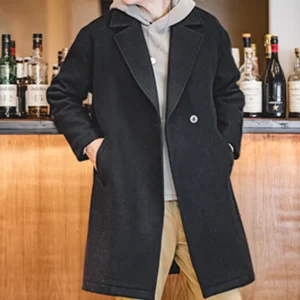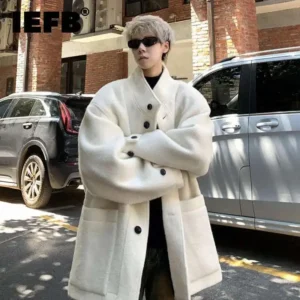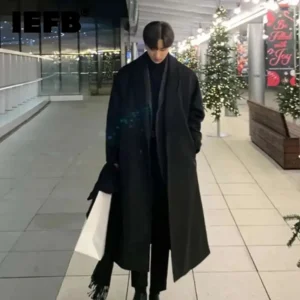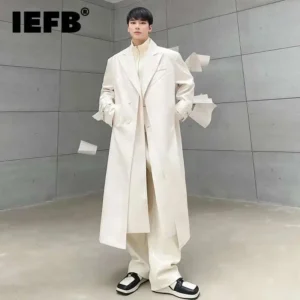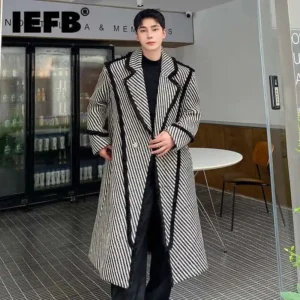Introduction: The Enduring Appeal of Tweed Coats
Tweed fabric, originating from the Scottish Highlands, has maintained its status as a symbol of timeless sophistication in menswear. This distinctive textile is characterized by its rugged texture, created through a complex weave of wool fibers that results in an unmistakable depth and character. What began as practical attire for the British countryside has evolved into a versatile fabric that bridges traditional heritage with contemporary style.
The appeal of tweed coats lies in their remarkable adaptability. They transition effortlessly from crisp autumn afternoons to chilly winter evenings, from country walks to urban commutes. This versatility extends beyond seasons to settings—a well-chosen tweed coat can be appropriate for occasions ranging from casual weekend outings to semi-formal events, making it a cornerstone of the modern gentleman’s wardrobe.
While the quality of construction and fit are certainly important, color selection stands as perhaps the most crucial decision when investing in a tweed coat. The right color not only determines how easily the coat integrates with your existing wardrobe but also influences its perceived formality, seasonal appropriateness, and ultimate wearability. Understanding the nuances of tweed colors—from classic earth tones to contemporary statement hues—can transform this investment piece from merely functional to truly extraordinary.
In this guide, we’ll explore traditional and modern tweed color palettes, provide practical styling advice for different contexts, and share insights on selecting hues that complement your personal coloring and lifestyle. Proper choosing right coat length is essential when selecting a tweed coat, as it affects both proportion and style. Whether you’re considering your first tweed purchase or expanding your collection, our comprehensive guide will help you navigate the rich and varied world of men’s tweed coats.
The Anatomy of Tweed Color: Understanding the Complex Weave
What separates tweed from other woolen fabrics is its remarkable depth of color—a quality created not through solid dyeing but through the artful blending of differently colored fibers. Unlike many modern textiles with flat, uniform appearance, tweed offers a living tapestry where colors interact and shift depending on distance and light conditions.
The visual complexity of tweed stems from its multi-layered color composition:
- Base colors provide the foundational tone and overall impression from a distance
- Contrasting flecks introduce visual interest and dimension
- Overlay patterns (such as herringbone or check) create structural depth
- Color blending through the weaving process produces subtle variations throughout the fabric
This complex interplay of hues creates a fabric that appears differently under various lighting conditions. A forest green tweed might reveal subtle blue undertones in natural daylight, while displaying richer, deeper green qualities under indoor lighting. This chameleon-like quality gives tweed its distinctive character and explains why these garments often look more interesting and nuanced than their solid-colored counterparts.
Understanding Tweed Color Composition
The distinctive appearance of tweed fabric comes from its unique construction method. Unlike fabrics dyed as finished cloth, tweed’s color complexity begins at the yarn stage. Multiple colored fibers are blended before spinning, creating yarns with inherent depth and variation. When these yarns are woven together, they produce a rich tapestry of color that can’t be replicated in simpler fabrics.
Traditional Harris Tweed from Scotland’s Outer Hebrides exemplifies this technique, where local weavers might combine up to twelve different colored wool fibers to create a single yarn. This produces the characteristic “heathered” look where colors appear to blend and shift. Donegal tweed from Ireland takes a different approach, using a more uniform base color punctuated with vibrant flecks of contrasting colors—traditionally representing the natural colors of the Irish countryside.
Modern tweed production maintains these traditional techniques while incorporating contemporary dyeing methods that allow for greater color consistency and expanded palette options. Understanding this complex color composition helps explain why a seemingly simple brown tweed coat might contain threads of rust, gold, blue, and green—giving it remarkable versatility when paired with other garments. The enduring legacy of tweed in menswear stems partly from this sophisticated approach to color.
Classic & Timeless Tweed Coat Colors
The foundation of tweed’s enduring appeal rests on a palette of classic colors that have remained fashionable for generations. These traditional hues—ranging from sophisticated greys to rich browns, forest greens, and deep blues—form the backbone of tweed’s heritage and continue to represent the most versatile and accessible options for today’s wearer.
These colors have persisted not merely out of tradition but because they brilliantly balance versatility with character. Emerging from tweed’s origins in the Scottish and Irish countryside, they reflect the natural landscapes that inspired them—heathered hills, stone walls, and earthy terrain. Yet these same colors transition effortlessly to urban environments, complementing modern wardrobes while maintaining their distinctive character.
Grey Tweed: The Epitome of Versatility
Grey tweed stands as perhaps the most adaptable choice in the tweed spectrum, offering remarkable flexibility across settings from boardroom to weekend outings. The beauty of grey lies in its chameleon-like ability to shift between formal and casual contexts with ease.
The grey tweed family offers considerable variety:
- Charcoal grey: Deep and sophisticated, ideal for business settings and evening wear
- Mid-grey: The ultimate all-rounder, pairing equally well with navy, burgundy, or earth tones
- Light grey: Fresh and contemporary, particularly flattering in herringbone patterns
- Salt-and-pepper: Featuring black and white fibers creating visual texture and dimension
Grey tweed particularly excels in herringbone and barleycorn patterns, where the texture creates subtle movement and depth. For styling, grey tweed coats pair beautifully with navy trousers, burgundy accessories, and virtually any color shirt. They transition smoothly between seasons, though lighter greys feel more appropriate in spring while deeper charcoals suit winter’s somber mood.
For those building their first quality coat wardrobe, a mid-grey herringbone tweed represents perhaps the safest yet most rewarding investment. Our collection of men’s grey overcoats includes several tweed options perfect for versatile wear.
Brown Tweed: Grounded in Heritage
Brown tweed embodies the rich heritage of this fabric, connecting directly to its countryside origins while maintaining surprising versatility in contemporary wardrobes. The earthy warmth of brown creates an inviting, approachable character that balances rugged masculinity with refined elegance.
The brown tweed spectrum includes:
- Chocolate brown: Rich, deep, and particularly flattering for formal occasions
- Tan/camel: Lighter, more casual, excellent for daytime wear
- Russet/copper: Warm reddish-browns that add distinctive character
- Tobacco brown: Multi-toned medium brown with golden undertones
- Fawn: Lighter brown with grey undertones for a softer appearance
Brown tweed creates particularly harmonious combinations with blue shirts, cream knitwear, and green accessories. The rich depth of brown tweed makes it an autumn champion, though it works well through winter and can extend into early spring with appropriate styling. Traditional country patterns like windowpane checks and thornproof textures find their most authentic expression in brown tweeds.
For those drawn to tweed’s heritage aspects, brown offers the most authentic connection to tradition while remaining remarkably wearable in modern contexts. Its natural warmth flatters most skin tones and creates an approachable elegance that more austere colors sometimes lack.
Green Tweed: The Countryside Essential
Green tweed captures the essence of British countryside tradition, drawing direct inspiration from the rolling hills and forest landscapes where tweed first gained popularity. Once primarily associated with hunting and outdoor pursuits, green tweed has evolved into a sophisticated option that bridges rural heritage and urban style.
The green tweed palette offers remarkable diversity:
- Forest green: Deep and rich, a traditional favorite with remarkable depth
- Moss green: Muted and versatile with grey undertones
- Sage green: Lighter with distinctive dusty quality, increasingly popular in contemporary collections
- Olive green: Military-inspired with remarkable versatility
- Loden green: Traditional Austrian hunting green with distinctive character
Green tweed coats pair wonderfully with earth tones, creating harmonious combinations with tan, brown, and cream. For contrast, burgundy accessories add a sophisticated touch that complements green’s natural character. Understanding proper men’s coat length is particularly important with distinctive colors like green, as proportions significantly impact the overall impression.
While historically associated with autumn and winter country wear, green tweed has found new life in urban settings, where its natural color provides a refreshing counterpoint to city greys. The recent trend toward nature-inspired color palettes has only enhanced green tweed’s appeal, making it increasingly popular among style-conscious men seeking distinctive yet versatile options.
Blue Tweed: A Modern Classic with Depth
Blue tweed represents something of a paradox—it’s a relative newcomer to the traditional tweed palette yet has quickly established itself as a modern classic. While browns and greens dominated historic tweed collections, blue emerged as an urban-friendly alternative that retains tweed’s character while offering exceptional versatility in contemporary wardrobes.
The blue tweed spectrum includes:
- Navy blue: Deep and rich, offering formal versatility similar to a navy blazer
- Indigo blue: Medium-dark with distinctive character reminiscent of quality denim
- Slate blue: A blue-grey hybrid with exceptional sophistication
- Steel blue: Cooler tones with grey undertones for modern appeal
Blue tweed coats excel in business environments, where they pair naturally with grey trousers, white or light blue shirts, and burgundy or gold accessories. The depth of blue tweed creates interesting visual texture even in simpler patterns like herringbone or barleycorn, while more complex check patterns gain sophistication in blue palettes.
The year-round versatility of blue tweed gives it practical advantages—deep navy tweeds work beautifully through winter, while lighter blues can extend into spring and autumn. For those seeking a tweed coat with maximum versatility across both casual and formal settings, blue offers perhaps the most balanced option in the traditional color spectrum.
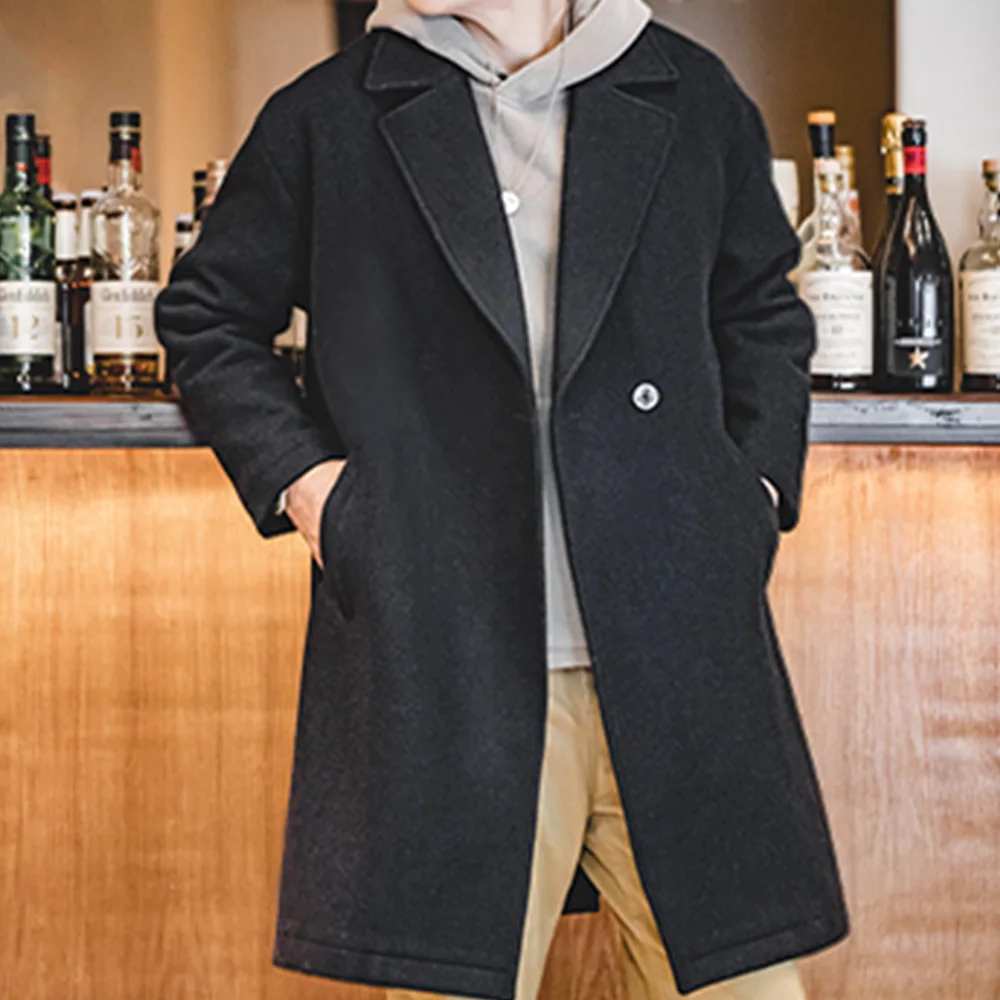
Modern & Distinctive Tweed Coat Colors
While traditional colors form the foundation of tweed’s appeal, contemporary designers and mills have expanded the palette considerably. Today’s tweed spectrum embraces more adventurous colors that maintain the fabric’s distinctive texture and character while introducing fresh visual impact. These modern options represent the evolution of tweed from purely traditional country wear to fashion-forward urban attire.
Modern dyeing techniques have enabled more consistent and vibrant colors while maintaining tweed’s characteristic depth. This technical innovation allows for statement hues that would have been difficult to achieve with traditional methods. The best contemporary tweed colors strike a balance—distinctive enough to stand out while maintaining sufficient versatility for regular wear.
Black Tweed: Urban Edge and Sophistication
Black tweed offers a compelling contradiction—it brings urban sophistication to a traditionally rural fabric. Unlike flat black woolens, black tweed displays remarkable depth through its textural variations and often includes subtle flecks of charcoal, blue, or even brown that become visible upon closer inspection.
The sophistication of black tweed makes it particularly suitable for evening wear and formal occasions, where it presents a more interesting alternative to smooth black wool. In daylight, its textural qualities prevent it from appearing too severe, while in artificial light, it maintains an elegant presence without the flatness of solid black.
For styling, black tweed creates striking monochromatic ensembles when paired with charcoal trousers and grey knitwear. For more contrast, white shirts and burgundy accessories offer classic combinations. Black tweed particularly excels with silver-toned accessories like watches and cufflinks, which highlight its sophisticated character.
Our collection of men’s black wool coats includes several tweed options that demonstrate how this urban-friendly color can maintain tweed’s distinctive character while offering exceptional versatility for city wear.
Burgundy & Berry Red Tweed: A Statement of Warmth
Burgundy and berry-toned tweeds introduce rich, warm character to the traditionally muted tweed palette. These colors make a confident statement while maintaining surprising versatility, particularly during autumn and winter months when their deep warmth feels most appropriate.
The spectrum includes:
- Burgundy: Deep red with purple undertones, sophisticated and versatile
- Maroon: Slightly darker with brown undertones for a more subdued effect
- Berry: Brighter red-purple tones for more distinctive character
- Rust: Orange-red tones that connect to traditional earth colors while adding vibrancy
These rich reds work best in subtle patterns—herringbone or plain weaves allow the color itself to make the statement without competing patterns. For styling, they pair beautifully with navy, grey, and cream, creating elegant combinations that balance their distinctive character with classic elements.
Burgundy and berry tweeds particularly excel in winter city wear, where their rich tones bring warmth and character to urban environments. While making a stronger statement than neutral tweed colors, they remain surprisingly wearable when paired with simpler, complementary pieces that allow the coat to be the focal point of an ensemble.
Purple & Heather Tweed: Unique and Refined
Purple-toned tweeds connect to both tradition and innovation—“heather” has long described the purple-hued landscapes of Scottish moorlands, while contemporary purples offer sophisticated alternatives to more common tweed colors. These distinctive hues range from subtle lavender undertones to rich aubergine depths.
The most wearable purple tweeds typically feature muted tones that read as sophisticated neutrals with distinctive character rather than bold fashion statements. Often, purple appears as an undertone or as flecks within a more neutral base, creating depth and interest without overwhelming versatility.
Styling purple-toned tweeds requires thoughtful balance—neutral companions like grey trousers and white or light blue shirts allow the subtle complexity of the color to shine without competition. Silver accessories complement the cool undertones of most purple tweeds, while brown leather adds warming contrast.
These unique colors excel in transitional seasons—spring and autumn—when their connection to natural landscapes feels most authentic. While more distinctive than traditional tweed colors, well-chosen purple and heather tweeds offer sophisticated character while maintaining surprising versatility.
Mustard Yellow & Ochre Tweed: A Pop of Character
Mustard yellow and ochre tweeds occupy an interesting middle ground between tradition and bold statements. These golden tones have historical precedent in traditional tweeds yet offer distinctive character that stands apart from more common neutrals. Their warmth brings immediate visual interest to autumn and winter wardrobes.
The gold-toned tweed spectrum includes:
- Mustard: Vibrant yellow with brown undertones
- Amber: Golden yellow-orange with rich depth
- Ochre: Earthy yellow-brown with historical connections
- Gold: Brighter yellow tones for maximum impact
These colors work best when the overall pattern remains relatively subtle—herringbone or plain weaves allow the distinctive color to speak for itself. For styling, navy and dark brown create sophisticated anchors that balance the visual impact of gold tones. Grey can also work beautifully, creating a cooler contrast with the warmth of mustard or ochre.
While certainly making more of a statement than traditional tweed colors, these golden hues connect beautifully to autumn landscapes and bring distinctive character to urban environments. For the confident dresser seeking a tweed coat with personality, mustard and ochre options offer distinctive flair while maintaining enough versatility for regular wear.
Multi-Tonal & Flecked Tweed: Dynamic Depth
Perhaps the most authentic expression of traditional tweed craftsmanship comes through multi-tonal and heavily flecked varieties that showcase the fabric’s unique ability to blend multiple colors into cohesive yet complex wholes. These tweeds feature remarkable depth that reveals different aspects depending on viewing distance.
Donegal tweed exemplifies this approach with its characteristic base color punctuated by vibrant flecks of contrasting colors. Harris Tweed often takes a more blended approach, with multiple colors woven together to create heathered effects that shift and change in different lights. Both traditions create fabrics with exceptional visual interest and remarkable versatility.
The practical advantage of multi-tonal tweeds lies in their ability to incorporate multiple colors from your wardrobe—a brown tweed with blue and green flecks naturally complements shirts and accessories in those hues. This intrinsic versatility makes coordinating outfits remarkably straightforward. Additionally, the complex surface texture helps disguise minor stains or wear, enhancing longevity.
When styling multi-tonal tweeds, it’s generally best to keep other elements relatively simple—solid-colored shirts and accessories allow the coat’s complex character to remain the focal point without creating visual competition. Our collection of men’s wool overcoats includes several multi-tonal tweed options that demonstrate this distinctive approach to color.
Understanding Tweed Patterns and Their Effect on Color Perception
The color of a tweed coat cannot be separated from its pattern—the two elements work in concert to create the overall visual impression. Patterns affect how colors are perceived, how formal or casual the coat appears, and how easily it integrates with other items in your wardrobe.
Pattern scale plays a crucial role in determining impact. Smaller, tighter patterns like fine herringbones create more subtle effects where the color blends into a more uniform appearance from a distance. Larger patterns like bold checks create more visual interest but require more careful styling consideration. Traditional patterns carry specific historical associations—herringbone has city sophistication, while countryside checks reference rural heritage.
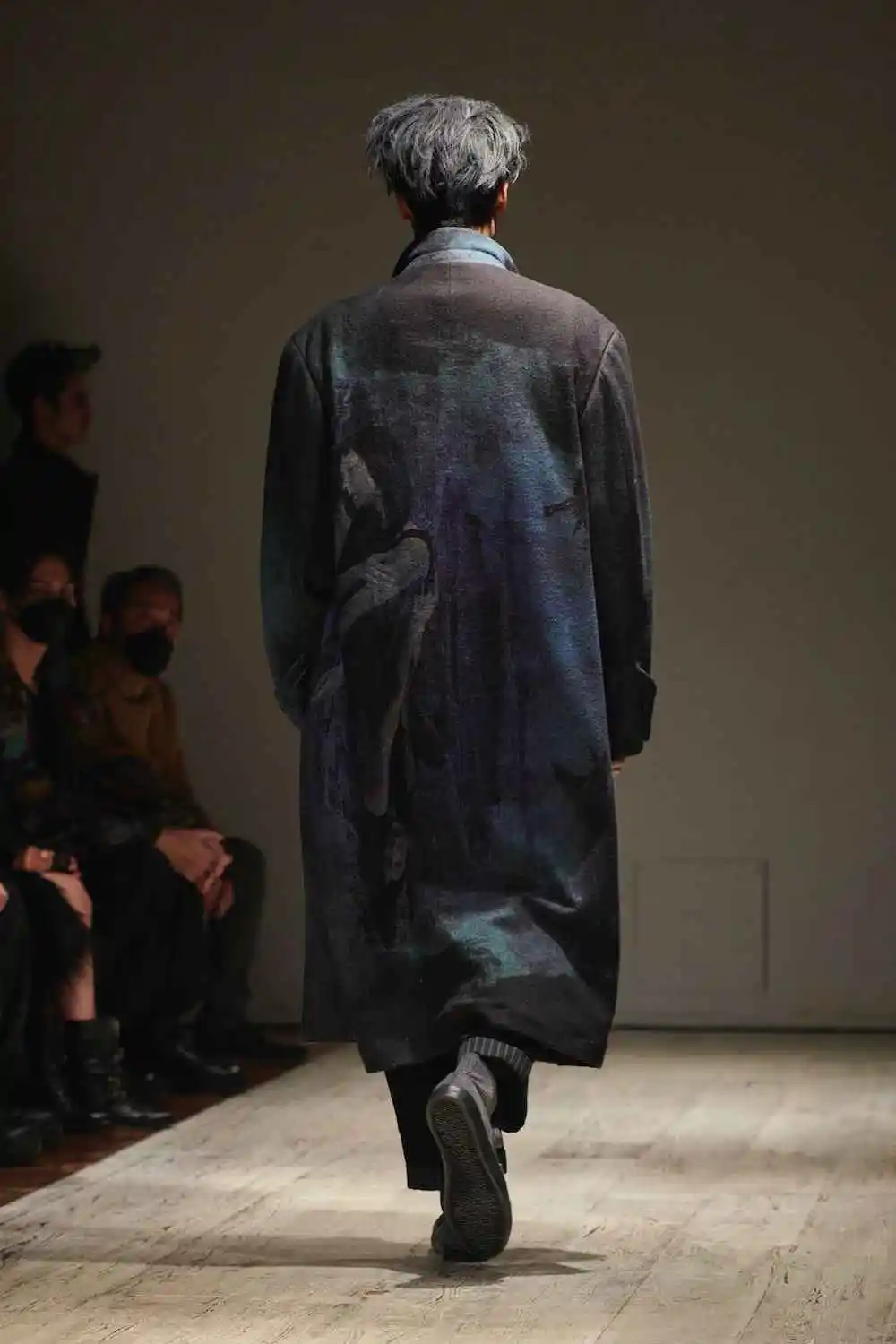
Herringbone: Classic Texture, Subtle Color Play
Herringbone stands as perhaps the most versatile and city-appropriate tweed pattern. Its distinctive zig-zag weave creates visual texture that adds depth to color without overwhelming visual impact. From a distance, herringbone tweeds often read as solid colors, revealing their sophisticated pattern only upon closer inspection.
This pattern particularly enhances the perception of color depth through its alternating directional weave. As light hits the fabric from different angles, sections appear slightly darker or lighter, creating subtle movement and dimension. This effect is particularly striking in grey herringbones, where the pattern creates a sophisticated silver-to-charcoal shift depending on the viewing angle.
Herringbone works exceptionally well across the entire tweed color spectrum but particularly enhances blues, greys, and browns. Its refined character makes it appropriate for business settings while maintaining enough texture for casual wear, making it the most versatile pattern for first-time tweed buyers. Our collection of men’s herringbone coats showcases this pattern’s remarkable versatility across different colors.
Houndstooth & Check Patterns: Bold Structure, Defined Hues
Check patterns in tweed create more defined color relationships through their structured contrast. Unlike the subtle blend of herringbone, checks place colors in direct juxtaposition, creating more distinct visual interest and often incorporating multiple hues within a single fabric.
Major tweed check varieties include:
- Prince of Wales: Sophisticated glen check with fine overlaid pattern
- Windowpane: Bold, widely-spaced lines creating rectangular spaces
- Gun club: Complex check incorporating four colors in a distinctive pattern
- District checks: Various traditional patterns associated with specific regions or estates
- Tartan: Colorful Scottish patterns with clan associations
Check patterns enhance color perception by creating clear boundaries between hues. In a windowpane pattern, the contrasting lines stand out against the base color, while district checks blend multiple complementary colors in structured relationships. These patterns often incorporate more colors than herringbone tweeds, allowing for greater complexity and interest.
When selecting checked tweeds, consider scale carefully—larger, bolder checks make stronger statements but may limit versatility, while smaller, more subtle checks offer greater flexibility across different contexts. Learning more about best colors for herringbone coats can provide additional insight into color selection for patterned outerwear.
Mens Black Overcoat, Mens Black Wool Coat, Mens Wool Overcoat
$339.18 Select options This product has multiple variants. The options may be chosen on the product pageMens Grey Overcoat, Mens Wool Blend Coat, Mens Wool Overcoat
$201.28 Select options This product has multiple variants. The options may be chosen on the product pageMens Herringbone Coat, Mens Long Overcoat, Mens Wool Overcoat
Price range: $197.16 through $203.69 Select options This product has multiple variants. The options may be chosen on the product pageMens Long Overcoat, Mens Tweed Coat
Price range: $397.49 through $409.96 Select options This product has multiple variants. The options may be chosen on the product pageMens Long Overcoat, Mens Wool Overcoat
$259.00 Select options This product has multiple variants. The options may be chosen on the product pageMens Long Wool Coat, Mens Tweed Coat, Mens Wool Blend Coat, Mens Wool Overcoat
$284.16 Select options This product has multiple variants. The options may be chosen on the product page
Choosing the Best Tweed Color for Your Personal Style
While understanding general color principles provides valuable guidance, selecting the ideal tweed coat ultimately requires personal consideration. Beyond trends and traditions, the perfect tweed color should complement your individual characteristics, integrate with your existing wardrobe, and suit your lifestyle needs.
Finding this personal sweet spot involves balancing several factors—your natural coloring, your typical dress code, the occasions where you’ll wear the coat, and your personal color preferences. The most successful tweed coat purchases align these considerations to find options that feel both personally resonant and practically versatile.
Complementing Your Skin Tone and Coloring
Your natural coloring—skin tone, hair color, and eye color—creates a unique palette that interacts with clothing colors in meaningful ways. Understanding your personal coloring can help identify tweed colors that naturally enhance your appearance rather than clash with it.
The simplest approach divides coloring into warm and cool undertones:
- Warm undertones: Golden, yellow, or peachy skin tones; red, auburn, or golden brown hair
- Cool undertones: Pink, bluish, or olive skin tones; ash brown, black, or platinum blonde hair
For warm coloring, tweed colors with yellow or red undertones often look most harmonious—camel, golden brown, rust, and forest green tend to complement this palette beautifully. Those with cool coloring often look best in tweeds with blue or purple undertones—charcoal grey, navy, slate blue, and cool greens like sage typically enhance this coloring.
Beyond this basic division, seasonal color analysis offers more nuanced guidance, dividing coloring into Spring, Summer, Autumn, and Winter types, each with specific complementary colors. While this system offers valuable insights, even the simpler warm/cool distinction can significantly improve your tweed color selections.
Integrating with Your Existing Wardrobe
A well-chosen tweed coat should integrate seamlessly with your current clothing collection, enhancing rather than requiring an entirely new wardrobe. Consider the dominant colors in your existing shirts, trousers, and accessories when selecting tweed colors.
For wardrobes dominated by blues (navy trousers, blue shirts), grey and brown tweeds offer exceptional versatility. If earth tones prevail in your closet, green and brown tweeds will integrate most naturally. For those who wear primarily grey trousers, nearly any tweed color can work well, though blues and browns offer particularly harmonious combinations.
Consider creating a simple wardrobe inventory before investing in a tweed coat. Identify your:
– Most frequently worn trousers (usually navy, grey, or khaki)
– Core shirt colors (typically white, blue, or patterns)
– Essential accessories (ties, pocket squares, scarves)
The ideal tweed coat color will complement most of these items, maximizing versatility and wear opportunities. This practical approach ensures your investment delivers genuine value through regular use rather than becoming an occasional special item.
Considering Purpose and Setting
The contexts where you’ll wear your tweed coat should significantly influence color selection. Different environments and occasions call for different approaches to color, pattern, and overall impression.
For professional environments:
– Grey, navy, and subtle brown tweeds project appropriate formality
– Smaller patterns like herringbone maintain professional appearance
– Darker colors generally communicate greater formality
For casual weekend wear:
– Greens, browns, and more distinctive colors offer relaxed character
– Larger patterns and more textured weaves embrace tweed’s casual roots
– Lighter colors work well for daytime casual contexts
For versatility across multiple settings:
– Mid-tone greys and blues transition most seamlessly between environments
– Herringbone and small patterns maintain flexibility
– Colors with both warm and cool elements adapt to different contexts
Understanding short vs long coats can also help determine the most appropriate tweed coat for your needs, as length affects both formality and practical functionality in different settings.
Mastering the Art of Styling Your Tweed Coat
Even the perfect tweed color requires thoughtful styling to reach its full potential. The rich texture and complex color composition of tweed creates distinctive opportunities for creating cohesive, sophisticated looks through careful coordination with other garments and accessories.
The fundamental principle for styling tweed effectively involves balancing complexity—the inherent texture and often multi-toned nature of tweed works best when paired with items that complement rather than compete with its visual interest. This doesn’t necessarily mean everything must be solid and simple, but rather that the overall composition should feel harmonious rather than chaotic.

Key Principles for Layering with Tweed
Tweed coats offer exceptional opportunities for sophisticated layering, creating depth through contrasting textures and complementary colors. Effective layering strategies enhance the coat’s character while creating practical warmth and versatility.
For grey tweed coats:
– Navy or burgundy knitwear creates sophisticated color depth
– White or light blue shirts provide clean contrast
– Charcoal or navy trousers create cohesive lower layers
For brown tweed coats:
– Forest green or burgundy sweaters enhance rustic character
– Cream or light blue shirts brighten the overall palette
– Navy or tan trousers complement the coat’s earth tones
For green tweed coats:
– Cream or tan knitwear creates natural harmony
– White or blue oxford shirts provide classic foundations
– Brown or grey trousers ground the distinctive coat color
For blue tweed coats:
– Grey or burgundy sweaters create sophisticated combinations
– White or striped shirts add formal versatility
– Grey or tan trousers offer appropriate contrast
The key with layering is creating a cohesive color story where each element complements rather than competes with the others. Using colors present in the tweed’s flecks for inner layers creates particularly harmonious combinations that highlight the coat’s depth.
The Power of Complementary Textures and Fabrics
Tweed’s distinctive texture creates opportunities for interesting fabric combinations that enhance its character while creating visual harmony. The most successful pairings balance textures to create depth without overwhelming complexity.
Complementary winter fabrics include:
– Flannel: Soft texture creates welcoming contrast with tweed’s rougher hand
– Corduroy: Ribbed texture complements tweed’s complexity while adding warmth
– Moleskin: Smooth surface creates sophisticated contrast with tweed’s texture
– Denim: Casual texture creates relaxed combinations with tweed’s heritage character
For spring and autumn transitions:
– Oxford cloth: Textured yet lighter weight shirts balance seasonal appropriateness
– Lightweight wool: Provides warmth without bulk for transitional temperatures
– Cotton twill: Offers appropriate weight and subtle texture for mid-season layering
When combining textures, consider visual weight—pairing tweed with fabrics of similar substantial appearance creates cohesive ensembles that feel purposeful and balanced. The goal is complementary contrast rather than jarring disconnection between elements.
Accessorizing Your Tweed Coat
Accessories provide the finishing touches that elevate tweed coat styling from good to exceptional. The right accessories highlight the coat’s colors, enhance its character, and create cohesive visual narrative throughout the entire outfit.
For scarves:
– Solid-colored cashmere or wool in complementary colors enhances sophistication
– Subtle patterns that incorporate colors from the tweed create cohesive connections
– Textures that contrast with tweed (smoother finishes) often work best
For hats:
– Classic styles like fedoras or flat caps respect tweed’s heritage
– Colors that complement rather than exactly match the coat avoid excessive coordination
– Materials with appropriate seasonal weight maintain balanced proportions
For gloves:
– Leather in brown or black provides classic functionality
– Subtle details like contrast stitching add sophisticated interest
– Weight appropriate to the coat’s weight ensures balanced proportions
When accessorizing tweed, restraint often yields the most sophisticated results—allow one or two well-chosen accessories to enhance the coat’s character rather than competing for attention. This approach honors tweed’s inherent complexity while creating put-together ensembles.
Seasonal Adaptations for Tweed Coat Colors
While traditionally associated with autumn and winter, tweed’s remarkable versatility extends across seasons through thoughtful color selection and styling. Different tweed colors naturally align with seasonal palettes, making some options more suitable for particular times of year.
Autumn and winter typically call for the richest, deepest tweed colors—chocolate browns, forest greens, navy blues, and charcoal greys harmonize beautifully with the season’s muted natural palette. These deeper colors also pair naturally with heavier fabrics and darker accessories typical of cold-weather wardrobes. The substantial weight of traditional tweed provides practical warmth during these months.
Spring and early autumn benefit from lighter tweed tones—tan, light grey, sage green, and slate blue connect to seasonal renewal while maintaining tweed’s distinctive character. Modern tweed blends incorporating linen or cotton create lighter-weight options appropriate for transitional months. These lighter tweeds often feature more open weaves and less substantial construction suitable for milder temperatures.
Thoughtful color selection can significantly extend a tweed coat’s seasonal versatility. Blues and greys typically offer the greatest year-round potential, while deep greens and browns read as more seasonally specific to autumn and winter. For maximum versatility, consider mid-tone colors with balanced warm and cool elements that adapt across seasonal shifts. Additional styling ideas can be borrowed from approaches used with men’s cashmere overcoats, which face similar seasonal considerations.
Maintaining the Color and Quality of Your Tweed Coat
The distinctive colors and textures of quality tweed require appropriate care to maintain their character over years of wear. Proper maintenance not only preserves appearance but also protects your investment in this heritage fabric.
To preserve tweed color vibrancy:
– Limit direct sunlight exposure during storage, which can fade colors over time
– Brush the fabric regularly with a soft clothes brush to remove surface dirt
– Address spills immediately by blotting (never rubbing) with a clean, damp cloth
– Allow wet tweed to dry naturally at room temperature, never using direct heat
For cleaning and storage:
– Dry clean sparingly, only when genuinely necessary (typically once per season)
– Use wood or shaped plastic hangers that support shoulders properly
– Allow adequate breathing room in closets to prevent moisture buildup
– Consider a breathable garment bag for off-season storage
Quality indicators in tweed coats include:
– Even coloration with rich depth and consistent pattern matching
– Natural movement and drape despite the fabric’s substantial weight
– Neat, consistent stitching with appropriate thread colors
– Proper pattern alignment at seams and closures
With proper care, a quality tweed coat should maintain its color vibrancy and structural integrity for many years, often improving in character as the fabric gently adapts to its wearer—a quality that makes tweed not just a purchase but a long-term wardrobe investment.
Which Tweed Color is Right for You? Final Considerations
Selecting the perfect tweed coat color ultimately requires balancing several key considerations: your personal coloring, existing wardrobe, lifestyle needs, and individual preferences. The ideal choice satisfies practical requirements while reflecting personal taste and enhancing your overall appearance.
For those new to tweed, the classic options—grey, brown, and navy—offer the greatest versatility and lowest risk. These colors have endured for generations precisely because they work so well across different contexts and with varied wardrobes. Mid-tones within these color families typically provide maximum flexibility, while darker shades offer greater formality and lighter tones create more casual impressions.
For those already owning a classic tweed coat, more distinctive colors—green, burgundy, or subtle patterns—can expand styling options while maintaining wearability. These secondary choices often bring greater personal expression while building upon the foundation established by more versatile first purchases.
Remember that quality construction and proper fit ultimately matter as much as color selection. A well-made tweed coat in any appropriate color will serve better than a poorly constructed garment in theoretically “perfect” color. Metro Cloak’s commitment to exceptional materials and construction ensures that whichever color you select, the garment itself will provide years of satisfaction through quality craftsmanship.
The enduring appeal of tweed lies in its remarkable ability to be simultaneously distinctive and versatile—making a quiet statement about quality and discernment while adapting to varied contexts and personal styles. With thoughtful color selection guided by the principles outlined here, your tweed coat can become not just a winter layer but a signature piece that enhances your entire wardrobe.


